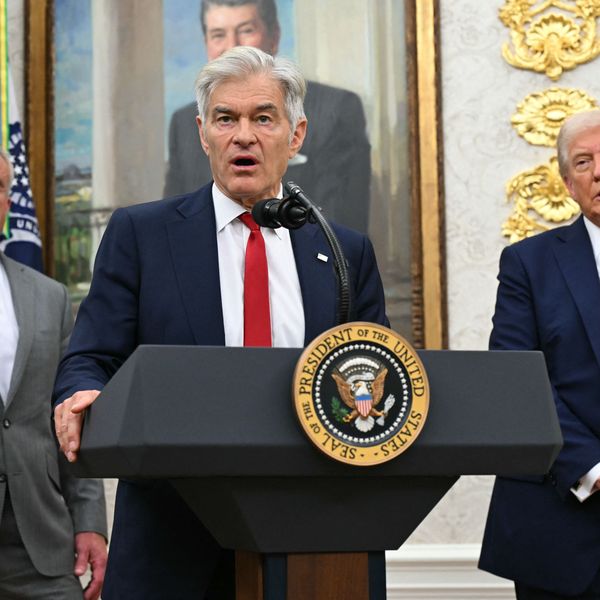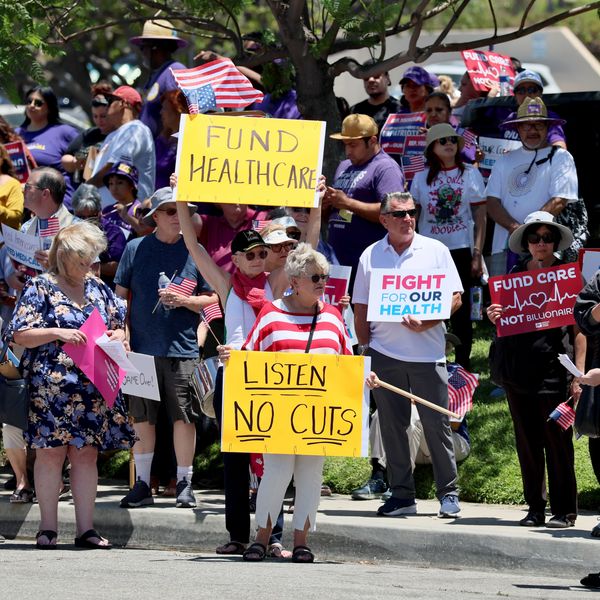
"Price increases for the top 20 most commonly prescribed brand-name drugs for seniors have driven an astonishing increase in sales revenue for their manufacturers," says a new report. (Photo: Chris Potter/flickr/cc)
Report Details How Skyrocketing Prescription Drug Costs Are Harming Nation's Seniors
Sen. Claire McCaskill says publication shows "that the pricing decisions made by these drug companies are outrageous."
A new report by Sen. Claire McCaskill (D-Mo.) shows how older Americans are getting hit by soaring drug prices while the pharmaceutical industry rakes in billions.
"Can you imagine if you went to an auto dealership and last year's exact model was being sold at a 20 percent mark-up, and then you went back the next year and it had happened again?" McCaskill said in a statement. "That's exactly what's happening in the prescription drug industry, where the cost of identical drugs skyrockets year after year."
For Manufactured Crisis: How Devastating Drug Price Increases Are Harming America's Seniors, the Committee on Homeland Security and Governmental Affairs (on which McCaskill is the top-ranking Democrat) looked at the 20 most-prescribed brand-name drugs for Medicare Part D beneficiaries. They include Crestor, Lyrica, Restasis, Symbicort, Tamiflu, and Xarelto.
Over the past five years, the prices for each of the 20 increased, on average going up 12 percent per year. That annual change, the report notes, is roughly 10 times higher than the average annual rate of inflation.
For 12 of the drugs, the prices increased over 50 percent between 2012 and 2017.
For six of the 20, the prices shot up more than 100 percent over the five-year period.
And for one drug--Nitrostat--the price soared 477 percent over the time span.
Paying for the medication can add up quickly, even for those with Medicare. The report notes, for example, that in 2013, "$1 out of every $5 that Medicare beneficiaries spent in out-of-pocket healthcare costs (excluding premiums) went towards prescription drugs."
The report also notes, "Even smaller percentage increases can result in significantly higher prices for expensive and commonly prescribed prescription drugs." Take, for example, Crestor, which went up 12 percent each year. In 2012, the weighted average wholesale acquisition cost was $349.31. In 2017, that cost was $615.65.
While seniors are feeling the sting of these increases, drug manufacturers are not.
"Price increases for the top 20 most commonly prescribed brand-name drugs for seniors have driven an astonishing increase in sales revenue for their manufacturers," the report states. "Despite the fact that total prescriptions written for these drugs decreased by more than 48 million between 2012 and 2017, total sales revenue resulting from these prescriptions increased by almost $8.5 billion."
According to McCaskill, the report shows "that the pricing decisions made by these drug companies are outrageous."
McCaskill's report comes the same month she led a bipartisan group of senators in introducing legislation (S.2554 and S.2553) addressing prescription drug costs. The group is hoping to bar so called "pharmacy gag clauses," which prevent pharmacists from letting consumers know if the medication they are seeking would cost less if paid out of pocket rather than through insurance.
Lowering the costs of prescription drugs could mean the difference between life or death, or at least a healthier life or death, for some. A CDC report from 2015 found that almost 7.8 percent of U.S. adults--roughly 25 million people--did not take their medication as prescribed, either skipping doses or not refilling prescriptions, in order to save money. Among those aged 65 and over, the percentage was 4.4 percent--over 14 million Americans.
An Urgent Message From Our Co-Founder
Dear Common Dreams reader, The U.S. is on a fast track to authoritarianism like nothing I've ever seen. Meanwhile, corporate news outlets are utterly capitulating to Trump, twisting their coverage to avoid drawing his ire while lining up to stuff cash in his pockets. That's why I believe that Common Dreams is doing the best and most consequential reporting that we've ever done. Our small but mighty team is a progressive reporting powerhouse, covering the news every day that the corporate media never will. Our mission has always been simple: To inform. To inspire. And to ignite change for the common good. Now here's the key piece that I want all our readers to understand: None of this would be possible without your financial support. That's not just some fundraising cliche. It's the absolute and literal truth. We don't accept corporate advertising and never will. We don't have a paywall because we don't think people should be blocked from critical news based on their ability to pay. Everything we do is funded by the donations of readers like you. Will you donate now to help power the nonprofit, independent reporting of Common Dreams? Thank you for being a vital member of our community. Together, we can keep independent journalism alive when it’s needed most. - Craig Brown, Co-founder |
A new report by Sen. Claire McCaskill (D-Mo.) shows how older Americans are getting hit by soaring drug prices while the pharmaceutical industry rakes in billions.
"Can you imagine if you went to an auto dealership and last year's exact model was being sold at a 20 percent mark-up, and then you went back the next year and it had happened again?" McCaskill said in a statement. "That's exactly what's happening in the prescription drug industry, where the cost of identical drugs skyrockets year after year."
For Manufactured Crisis: How Devastating Drug Price Increases Are Harming America's Seniors, the Committee on Homeland Security and Governmental Affairs (on which McCaskill is the top-ranking Democrat) looked at the 20 most-prescribed brand-name drugs for Medicare Part D beneficiaries. They include Crestor, Lyrica, Restasis, Symbicort, Tamiflu, and Xarelto.
Over the past five years, the prices for each of the 20 increased, on average going up 12 percent per year. That annual change, the report notes, is roughly 10 times higher than the average annual rate of inflation.
For 12 of the drugs, the prices increased over 50 percent between 2012 and 2017.
For six of the 20, the prices shot up more than 100 percent over the five-year period.
And for one drug--Nitrostat--the price soared 477 percent over the time span.
Paying for the medication can add up quickly, even for those with Medicare. The report notes, for example, that in 2013, "$1 out of every $5 that Medicare beneficiaries spent in out-of-pocket healthcare costs (excluding premiums) went towards prescription drugs."
The report also notes, "Even smaller percentage increases can result in significantly higher prices for expensive and commonly prescribed prescription drugs." Take, for example, Crestor, which went up 12 percent each year. In 2012, the weighted average wholesale acquisition cost was $349.31. In 2017, that cost was $615.65.
While seniors are feeling the sting of these increases, drug manufacturers are not.
"Price increases for the top 20 most commonly prescribed brand-name drugs for seniors have driven an astonishing increase in sales revenue for their manufacturers," the report states. "Despite the fact that total prescriptions written for these drugs decreased by more than 48 million between 2012 and 2017, total sales revenue resulting from these prescriptions increased by almost $8.5 billion."
According to McCaskill, the report shows "that the pricing decisions made by these drug companies are outrageous."
McCaskill's report comes the same month she led a bipartisan group of senators in introducing legislation (S.2554 and S.2553) addressing prescription drug costs. The group is hoping to bar so called "pharmacy gag clauses," which prevent pharmacists from letting consumers know if the medication they are seeking would cost less if paid out of pocket rather than through insurance.
Lowering the costs of prescription drugs could mean the difference between life or death, or at least a healthier life or death, for some. A CDC report from 2015 found that almost 7.8 percent of U.S. adults--roughly 25 million people--did not take their medication as prescribed, either skipping doses or not refilling prescriptions, in order to save money. Among those aged 65 and over, the percentage was 4.4 percent--over 14 million Americans.
A new report by Sen. Claire McCaskill (D-Mo.) shows how older Americans are getting hit by soaring drug prices while the pharmaceutical industry rakes in billions.
"Can you imagine if you went to an auto dealership and last year's exact model was being sold at a 20 percent mark-up, and then you went back the next year and it had happened again?" McCaskill said in a statement. "That's exactly what's happening in the prescription drug industry, where the cost of identical drugs skyrockets year after year."
For Manufactured Crisis: How Devastating Drug Price Increases Are Harming America's Seniors, the Committee on Homeland Security and Governmental Affairs (on which McCaskill is the top-ranking Democrat) looked at the 20 most-prescribed brand-name drugs for Medicare Part D beneficiaries. They include Crestor, Lyrica, Restasis, Symbicort, Tamiflu, and Xarelto.
Over the past five years, the prices for each of the 20 increased, on average going up 12 percent per year. That annual change, the report notes, is roughly 10 times higher than the average annual rate of inflation.
For 12 of the drugs, the prices increased over 50 percent between 2012 and 2017.
For six of the 20, the prices shot up more than 100 percent over the five-year period.
And for one drug--Nitrostat--the price soared 477 percent over the time span.
Paying for the medication can add up quickly, even for those with Medicare. The report notes, for example, that in 2013, "$1 out of every $5 that Medicare beneficiaries spent in out-of-pocket healthcare costs (excluding premiums) went towards prescription drugs."
The report also notes, "Even smaller percentage increases can result in significantly higher prices for expensive and commonly prescribed prescription drugs." Take, for example, Crestor, which went up 12 percent each year. In 2012, the weighted average wholesale acquisition cost was $349.31. In 2017, that cost was $615.65.
While seniors are feeling the sting of these increases, drug manufacturers are not.
"Price increases for the top 20 most commonly prescribed brand-name drugs for seniors have driven an astonishing increase in sales revenue for their manufacturers," the report states. "Despite the fact that total prescriptions written for these drugs decreased by more than 48 million between 2012 and 2017, total sales revenue resulting from these prescriptions increased by almost $8.5 billion."
According to McCaskill, the report shows "that the pricing decisions made by these drug companies are outrageous."
McCaskill's report comes the same month she led a bipartisan group of senators in introducing legislation (S.2554 and S.2553) addressing prescription drug costs. The group is hoping to bar so called "pharmacy gag clauses," which prevent pharmacists from letting consumers know if the medication they are seeking would cost less if paid out of pocket rather than through insurance.
Lowering the costs of prescription drugs could mean the difference between life or death, or at least a healthier life or death, for some. A CDC report from 2015 found that almost 7.8 percent of U.S. adults--roughly 25 million people--did not take their medication as prescribed, either skipping doses or not refilling prescriptions, in order to save money. Among those aged 65 and over, the percentage was 4.4 percent--over 14 million Americans.

